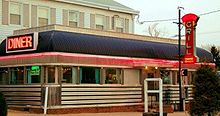Americana (culture)

Americana refers to artifacts of the culture of the United States, the history and folklore resultant from its westward expansion. Examples of this culture include baseball, apple pie, Superman, the Diner, barbed wire, wagon trains, and NASCAR; jazz, the music of Stephen Foster, George Gershwin's Rhapsody in Blue, the music of Aaron Copland (notably his Fanfare for the Common Man), and rockabilly; and American art, such as that of Frederic Remington, Grant Wood, and Norman Rockwell, all based on American folk art.
Music
In music, Americana is a loose subset of American folk music, that is perhaps best defined as "classic American music"—ranging in style from roots-based bluegrass to alternative country, gospel, blues, zydeco, and other native forms. One of the main reasons Americana is used to describe such a wide variety of musical genres is because of the diverse range of cultural influences which we call American. For example, traditional Bluegrass instrumentation consists of the banjo which originated on the African continent, guitars from Europe, and fiddling styles which have their roots in traditional Irish and other Gaelic fiddling techniques. The music group The Band is often cited as having the biggest modern influence[citation needed] on Americana, especially in rock and roll.
Today a growing collective of musicians from across the country are taking a darker, more rustic approach to the genre, creating a subculture commonly referred to as "Gothic-Americana". Many credit this style's origins to the artists that came from the Denver scene in the mid to late 90's, such as the Denver Gentlemen and 16 Horsepower. Today's gothic americana musicians blend traditional folk, gypsy, blues, bluegrass, and country with a much darker side, focused on songs of tragedy and murder. Pushed along by bands such as Slim Cessna's Auto Club and Jay Munly, Strawfoot, Gravemist, Reverend Glasseye, Curtis Eller, the Monads, Creech Holler, William Elliott Whitmore and many others, fans are growing in large numbers around the world, breathing new life into the Americana sound.
Americana bands and musicians
- The Allman Brothers Band
- The Band
- The Blasters
- Johnny Cash
- Creedence Clearwater Revival
- Bob Dylan
- Elvis Presley
- Woody Guthrie
- Merle Haggard
- Uncle Tupelo
- Heartsfield
- Waylon Jennings
- The Grateful Dead
- Bruce Springsteen
- Junkyard Jane
- Tom Waits
- 16 Horsepower
- Strawfoot
- William Elliott Whitmore
- Slim Cessna's Auto Club
- Curtis Eller
- Beat Circus
- Hank Williams
- Neil Young
- Old 97's
- Wilco
- Rhett Miller
- Continental Drifters
Americana Radio
This section needs expansion. You can help by adding to it. |
Americana is a format in commercial, non-commercial, terrestrial, satellite and internet radio. The Americana Music Association (AMA) has created a chart which documents Americana radio, with approximately 75 Americana radio stations and programs.
Visual Art
In the visual fine arts, Americana usually indicates a concern with the marginal aspects of historic American culture: carnivals, popular amusements such as side-shows, vernacular typography and signage, old horror movies in the 'haunted house' genre, the old West, and the backwoods cultures. It has increasingly veered off into a dark Gothic approach to Americana that was first visualised by U.S. writers such as Edgar Allan Poe and Ray Bradbury.
Americana Movies
Hootenanny Hoot (1963) - featuring Johnny Cash, Judy Henske, The Brothers Four, etc.
See also
- American Studies
- Americana/Lesourdesville Lake Amusement Park
- Australiana
- Canadiana
- Scouting in popular culture
External links
- Americana Music Association (Nashville)
- Americana UK - world's biggest alt-country website
- The Danans - UK based Americana band
- Americana Roots - Americana Music News & Resources
- Americana Radio Promotion Independent Radio Promotion for the Americana radio format
- [1] - Description of "Hootenanny Hoot"
- Americana Artist J. K. Coltrain (Nashville)
- Jaimie Muehlhausen - Americana indie musician
- HickoryWind.org - Americana, Bluegrass, & Alt Country News, Reviews, & Personality
